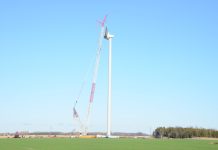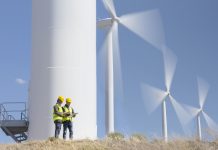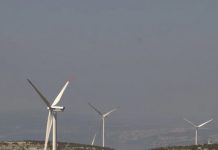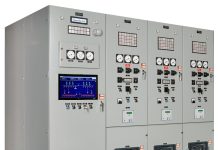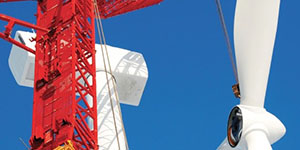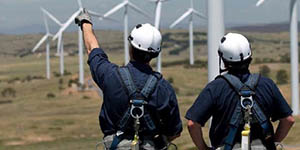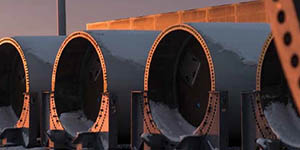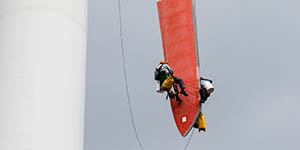Cable circuits connecting wind farms to the grid are subject to highly variable loading. The sizing of such cables according to conventional continuous rating methods, e.g. IEC 60287, can lead to some conservatism. Traditional daily loss load factors are also unsuitable for use with these circuits, as unlike demand driven circuits there is no discernible daily load cycle. This study uses electrical and thermal data from operational wind farm circuits to propose an alternative cyclic rating method for sizing such circuits.

1 Introduction
The transition toward a low carbon economy [1] has led to a large number of wind farms being connected to the U.K. electricity grid, with further installations planned. The cable circuits that connect the wind farm to the grid can be a significant proportion of the overall project cost, particularly for more remote sites where the nearest suitable substation may be more than 20 kilometers away. The current rating of the cable circuits is usually determined based on conventional continuous rating methodologies, such as IEC 60287 [2]. This approach neglects the fact that power from renewable sources is inherently variable and hence there can be many periods when assets are not fully utilized and true operating cable temperatures are much lower than the design maximum.
Given the widespread availability of distributed temperature sensing (DTS), it is possible to make real-time measurements of cable temperature. The temperature measured is not that of the conductor, but when coupled with thermal models, it is possible to use DTS systems to calculate dynamic current ratings (DCRs). SP Energy Networks, the company responsible for the operation of the electricity distribution networks in Southern Scotland and Merseyside & North Wales, has previously trailed the implementation of a DCR system to monitor the temperature of four 33 kV export cable circuits associated with four onshore wind farms in Scotland [3].
While DCR enables an operator to verify the thermal capacity of their cable circuits in real time, it cannot be used as a design tool; the cable circuit must still be designed using offline calculations with a suitable set of assumptions. This article presents a cyclic rating method that can be used for such calculations. Prior to presenting the new method, temperature measurements from an example installation are shown to demonstrate the potential benefits of using non-steady state methods.

2 Temperature monitoring method
The installation used as a case study for this article consists of four 33 kV wind-farm cable circuits connecting to East Kilbride South 275/33 kV substation in Scotland. In the following sections, the layout of the cable circuits and examples of measured temperatures are presented.
2.1 Cable circuits monitored
Figure 1 shows the layout of the cable circuits that connect windfarms A-E to the East Kilbride South substation. Circuits A-C consist of 3↔1c 630 mm2 Cu XLPE insulated cables, while circuit D consists of 3↔1c 240 mm2 Al XLPE insulated cables. Each circuit is installed in separate ducts arranged in a trefoil formation, with the sheaths solidly bonded. The ducts have an outer diameter of 160 mm and inner diameter of 150 mm. Circuits A-D share a common trench for the first 0.7 km from the substation. Circuits A-C continue to share a trench for the next 10 km until these circuits separate. The trench containing circuit A-C is crossed by two 275 kV circuits that connect wind farm E to the grid. Further circuit routing details may be found in [3].

2.2 DTS system architecture
The DTS fiber used to measure the cable circuit temperatures was installed in a separate micro-duct (internal diameter of 10 mm) in the center of each trefoil bundle as shown in Figure 2. The gap in the trefoil formation was chosen as the optimum location for the micro-ducts and thus the optical fibers. The fibers were jointed every 0.5 km, within 10 m of the 33 kV joint bays.
The DTS system is capable of measuring the temperature along the full length of each of the cable circuits at a resolution of 1 meter, with a temporal resolution of 30 minutes. The measurements are then fed into the DCR system, as shown in Figure 3, such that the conductor temperature may be estimated and the dynamic rating data may be made available to the network operator.

2.3 Location of hotspots
One particular benefit of using DTS systems is the ability to track the locations of hot spots along the circuit length. Figure 4 shows the spatial locations of the hottest points on Circuit B over an 8-months period. Red points represent the hottest point on the whole circuit, with blue representing the second hottest locations. It can be seen that in the latter part of the duration assessed, the hot spot locations have changed. This is due to circuit B being commissioned before the remaining circuits are operational, which has a mutual thermal impact on circuit B.

By reviewing the hot spot locations at the time of the highest loads, it was possible to identify the sections of the route that would need to be considered in the most detail when calculating the cyclic ratings. The hot spots were typically associated with localized increase in burial depth, either due to crossings with other circuits or underneath natural obstacles such as rivers. While a deeper section will often have a lower continuous rating, the thermal time constant is typically longer. This means that these sections stand to benefit most when a cyclic rating is considered.

Figure 5 shows an example of the fiber temperature distribution at five hot spots on circuit B. The most common temperature is approximately 17°C, which would represent a small rise above the standard soil temperature of 15°C, but peak temperatures of up to 39°C were measured within the fiber duct under the most onerous circuit loads.
3 Cyclic rating requirements
Conventional cyclic ratings, such as those given in U.K. Energy Networks Association (ENA) Engineering Recommendation (ER) P17 [4], are typically based upon a 24-hour domestic/residential load cycle. This is because they have typically been used to obtain ratings for cases where the circuit loading is demand driven, rather than generation driven.
3.1 Requirements
The basic requirements for the cyclic rating method for wind farm application were as follows:
- Simple square wave shape (for easy computation using analytical tools).
- Can be calculated either at the design stage, or as an up-rating of an existing installation.
- It should be feasible to calculate the rating without the use of finite element tools, or other advanced software.
- Given these requirements, the preferred strategy is to
i: Design a calculation which can be solved using either wind resource data to estimate a cable current, or using real circuit load data.
ii: Make use of existing IEC calculations for cyclic rating factors where possible.
3.2 IEC 60853 method
Two internationally standard methods for calculating cyclic ratings have been made available by IEC. IEC 60853-1 [5] contains a method that is valid for cables with rated voltages at 30 kV and below, while IEC 60853-2 [6] is valid for cables with rated voltage above 30 kV. The primary difference between the two calculations concerns the thermal model used for the cable itself. Cables at 30 kV and below have a shorter thermal time constant, as the thermal capacitance of the cable is smaller than would be the case for a higher voltage system. Hence IEC 60853-1 calculates the cyclic rating on the assumption that the cable thermal capacitance can be neglected, meaning that only the thermal capacitance of the surrounding ground is considered. This can also be appropriate for a buried 33 kV cable circuit.
The cyclic rating according to IEC 60853-1 is calculated by multiplying the continuous rating, Icont, by the cyclic rating factor M. The first step is to obtain the loss load factor, µ, given by Equation 1.

Yi is obtained by squaring the load cycle I(t), then normalizing against the maximum load squared, before decomposing into a series of hourly rectangular pulses Y0, Y1 and so on. Here i represents the number of hours prior to the expected peak temperature and n is the total number of hours considered.
Having obtained µ, Equation 2 is then used to obtain the value of the cyclic rating factor M.

Here ϑr(i) is the temperature rise at time i hours due to the application of a step function of load equal to the continuous rated load. The first half of (2) accounts for the transient response for the past ‘m’ hours and the remaining terms consider the historical response through the average loss factor. The ratio of temperature at time ‘i’ to steady state can be expressed by Equation 3:

Here λ(i) represents the transient temperature rise at the duct surface and is given by Equation 4:

where De, L, t, δ and N are the external diameter of the duct [m], burial depth [m], the point in time [s], thermal diffusivity [m2/s] of the soil and the number of active circuits, respectively. Whilst the left-hand side of the numerator in Equation 4 represents the thermal response of the cable under consideration, the right-hand term represents the impact of additional circuits. The distance from the cable in question to the additional circuits is given by Df, defined in Equation 5 as

The coefficient F used to express the steady-state mutual heating caused by the other cables in the group is Equation 6

Guidance on the means by which d′pk and dpk can be calculated for groups of circuits is given in [5]. It should be noted that some additional terms can become necessary as more circuits are added, or as the transient becomes longer.
The final outstanding term in Equation 3 is k1, which represents the ratio of the duct external surface temperature rise above ambient to the conductor temperature rise above ambient under steady-state conditions and is calculated by Equation 7

4 Defining a Load Cycle
This section presents the methods used to perform the cyclic rating calculations. The method has been adapted from that published in [7] to suit a 33 kV cable circuit.
4.1 Distribution of load
It is well known that the outputs of wind farms will vary with time as the prevailing weather changes. When the power curve of a wind turbine is taken into account, these two factors together will have a significant impact upon the time series loading of the cable circuit. Figure 6 shows the cumulative distribution of the normalized load on each of the cable circuits. It should be noted that circuits A and D have been in service for less than 1 year at the time of the data analysis being undertaken, therefore the shape of the distribution is slightly different to that of the remaining circuits.

The following features can be seen from Figure 6:
- For 50% of the time, the loading on all of the circuits is <30% of the maximum value (resulting in <10% of rated heat generation in the cables).
- Excluding wind-farm A (for which the least data was available), loading in excess of 80% of the rated value occurs for <20% of the time.
This demonstrates why a continuous rating method could prove to be very conservative. However, Figure 4 does not provide information about how the high and low loadings are distributed in time. This can be achieved through a persistence analysis.

4.2 Persistence analysis
The purpose of the persistence analysis is to allow the variables Δtrate and Δtlow shown in Figure 7 to be obtained. The procedure to perform the analysis can be summarized as follows:
- i: Obtain a long time series of wind speed data (or load current data).
- ii: Remove the effects of very short events, pass the times series data through a moving average filter with window length of 6 hours.
- iii: Define a critical value of wind speed (or load current) above which the loading on the cable is considered significant. This obtains the value Ilow, which will be assigned as the minimum load on the circuit.
- iv: Pass the filtered time series through a binary filter, such that any value I(t) ≤ Ilow is considered low loading, all others are considered as high loading.
- v: Calculate the duration of each spell of high and low loadings.
The result of this analysis will be a distribution of low and high load durations, which can then be assessed to determine suitable values for Δtrate and Δtlow.

The results of this analysis for the outputs of the five wind farms are presented in Table 1. It should be noted that the maximum values found for hours below the loading threshold may include planned downtime. The following section discusses the strategy for defining load cycles from this data.
4.3 Correlation analysis
Given that four of the cable circuits for the different wind farms share the same trench, it is important to consider the cross correlation of the loading on these circuits. Table 2 presents the maximum cross correlation of loading on the circuits, based on the original time series dataset. As the lowest correlation is 83%, it would be valid to assume that peaks in output would be coincident on all four circuits, i.e. the thermal worst case.

The cross correlation between the temperature data recorded by the DTS and the circuit loading has also been investigated. The key findings were
- i: The normalized cross correlation between load and temperature was high for all circuits, typically in excess of 94%.
- ii: For the majority of the hot spots tested, the lag between the high load and resulting thermal response was in the region of 2.5 to 3 hours. This matches well with the expected thermal time constant of the 33 kV cable system. Given that the thermal response of the soil is very slow, the temperature does continue to rise after this time but at a much-reduced rate.
The time lag between the load and the thermal response is clearly much shorter than the mean persistence values shown in Table 1. Therefore, the use of IEC 60853-1, i.e. neglecting the cable thermal capacitance in calculating the cyclic rating factor, is a reasonable assumption.
4.4 Cycles defined
Taking the results of the persistence analysis and the cross-correlation analysis together, it is reasonable to that circuits A-D can all be represented by the same load cycle. This is because the persistence values are comparable and there is strong correlation between the peaks in load. Taking averages and discounting some potentially atypical data, the values proposed for the variables in Figure 7 are
• Ilow = 0.5Icont.
• Δtrate = 21 h and Δtlow = 65 h.
Applying this cyclic load within the modified IEC 60853-1 calculation, a potential 17% increase in wind-farm generation uniformly across all wind farms is possible with an assumed 78°C thermal limit. When a more complex model is used to calculate the thermal response, taking full account of the thermal capacitance of the cable, the cyclic rating factor obtained is very comparable. These results are for a generic circuit installation and care should be taken to consider potential thermal pinch points, as this would restrict any permissible generation increase.
5 Lessons learned
Based on experience of applying this method to several case studies, the following points should be considered prior to using the method:
- i.: To obtain a representative cyclic load curve, the minimum acceptable length of the circuit loading time series input is one year, although more data would be preferable.
- ii: The value of Ilow selected must be sufficiently low that if such a load was applied constantly the increase in soil temperature around the cable would be minimal.
- iii: When conducting the persistence analysis, it can be beneficial to solve additionally for a threshold of 80% of rated load to identify the durations of the worst-case peak loads.
- iv: Analysis of DTS data shows that circuit hot spots can move between seasons, which may mean that multiple sections need to be rated with the lowest common rating being chosen for the circuit.
- v: Sections of cable installed “in air” may have a higher continuous rating, but their short time constant may mean that they reach steady-state conditions within the duration of a single peak. Coordination of ratings between sections is essential.
6 Conclusions
This article has presented an approach for calculating enhanced ratings for cable circuits connecting wind farms to the grid. The numerical analysis required to design the cyclic load profiles can be completed using a wide range of software.
By adapting the existing IEC 60853 calculation, it is possible to assess the cyclic ratings without the need to solve long duration transient models. Care must be taken in selecting appropriate values of Δtrate and Δtlow if the available time series of data is short, as it is possible that the data will not fully reflect extreme values.
For the case studies considered to date, rating enhancements of about 25-35% above the IEC 60287 rating have been found to be possible, particularly for deeply buried cables. It is recommended that a DTS system should be installed if a wind-farm circuit is designed on this basis, unless additional analysis can be completed to demonstrate that the load cycle chosen is sufficiently conservative.
7 Acknowledgments
This work was funded through U.K. Office of Gas and Electricity Markets (Ofgem) Low Carbon Network funding (LCNF) mechanism.
References
- UK Government: ‘The carbon plan: delivering our low carbon future’, 2011
- IEC 60287, Electric cables – calculation of the current rating.
- SP Energy Networks: ‘Temperature monitoring of windfarm cable circuits – close down report’. SPT1005, July 2015. Available at www.smarternetworks.org/Project.aspx?ProjectID=420.
- Energy Networks Association ER P17, Current ratings for distribution cables.
- IEC 60853-1: ‘Calculation of the cyclic and emergency current rating of cables, Part 1: cyclic rating factor for cables up to and including 18/30(36) kV’, 1985.
- IEC 60853-2: ‘Calculation of the cyclic and emergency current rating of cables, Part 2: cyclic rating of cables greater than 18/30 (36) kV and emergency ratings for cables of all voltages’, 1989.
- Catmull S., Chippendale R.D., Pilgrim J.A., et al: ‘Cyclic load profiles for offshore wind farm cable rating’, IEEE Trans. Power Deliv., 2016, 31, (3), pp. 1242–1250 (10.1109/TPWRD.2015.2469538)




